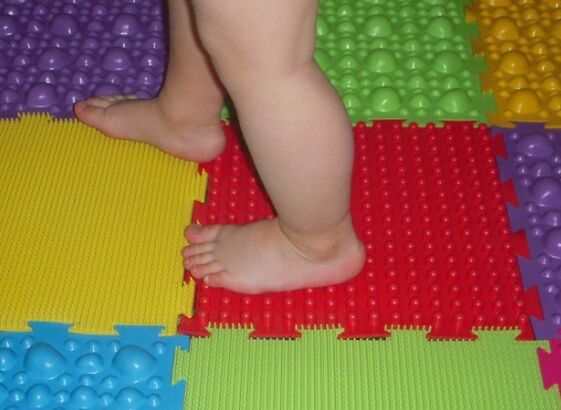Valgus deformation of the foot in children is quite common in orthopedic practice-there are 100 healthy children with varying degrees of flat legs of 100 healthy ones.This diagnosis should not be scared, you need to understand the problem and start solving it under the guidance of an experienced specialist.In most cases, the curvature of the legs is treated at home with the help of exercise, massage and other auxiliary methods, and only in the advanced stage is surgery required.
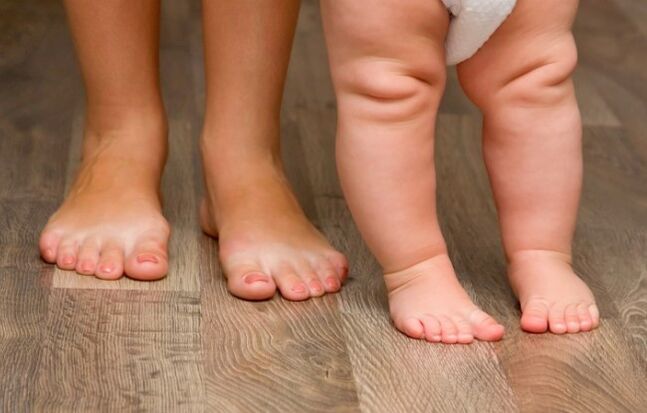
What is valgus and flat deformation?
Valgus' foot is a change in the axles of the lower limbs, in which the leg floods inside and the area of the heel and fingers are protruding outwards.With the timely diagnosis and implementation of all the doctor's recommendations, the defect is adjusted and the right set of leg is formed.Lack of treatment leads to deformation of flat valgus of the foot and a change throughout life in the functioning of the musculoskeletal system.
Signs and symptoms of Valgus deformation in a child
The deformation of the foot in children is diagnosed for 1-1.5 years when the baby starts to walk alone.In the case of congenital pathology, the orthopedist will notice the deviation from the norm of 2-3 months of the baby's life.
Parents can recognize the onset of the disease themselves, noting that the child incorrectly steps on their feet, displacing the center of gravity inside.The gait can be cumbersome, massed, pronounced flat legs are observed.If you place your child directly and collect your knees, a distance of 4-5 centimeters is formed between the legs.With the development of deformation on both sides, the legs acquire the outline of the letter "X".There is a comparison of this pathology with "kissing knees" (see photo).
Improper load distribution leads to rapid fatigue of the child, often prefers passive games, avoids physical activity.The greater children often complain of pain in the lower leg, joints and spine, and by the evening swelling of the legs may occur.Gradually the fingers and heels deform and deviate, the skin of the feet thickens, calluses appear.The shoes in a child with such deformation of the foot are torn unevenly - the inside of the sole is wiped out faster.
Anatomical and functional flat legs and their reasons
All newborns have anatomical flat legs as the muscles, ligaments and tendons are constantly calm.When the child starts to get up and tries to walk, the ligamentum is enhanced and the right arch of the foot is formed.If this does not happen, orthopedists speak of the development of functional flat feet.
The reasons for the development of flat feet in young children:
- The consequences of lack of calcium and other trace elements during pregnancy.A woman should follow all the doctor's recommendations, stick to a healthy lifestyle and eat properly.
- Genetic factor.The pathology can be inherited, so if flat feet are present in the parents, attention should be paid to preventing the deformation of the legs in the child.
- Transferred rickets.One of the reasons for the pathological formation of the foot is the lack of vitamin D. The bones are softened, the musculoskeletal system is curved and the set of the foot is flattened.
- Early setting of the legs.Although the baby may want to rely on the legs, do not let him do this earlier than 7-8 months.
- Improperly selected shoes are too free or tight, on flat soles.Do not buy shoes for the child for growth (the delivery is left to be a maximum of one size) as the foot will be in a free position.Walking barefoot on a flat surface (house on the floor).
- The following diseases can provoke flat installation of the legs: cerebral palsy, polio, obesity, congenital dislocation of the thigh.Various leg injuries, long -term gypsum stay.
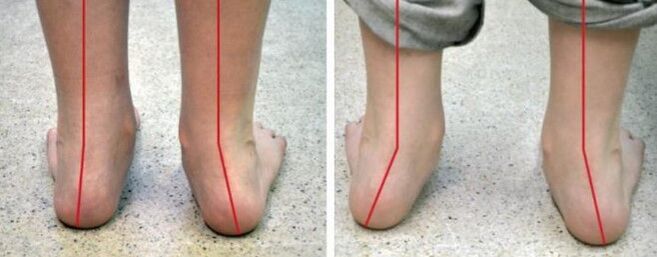
The degree of development of pathology
There are four degrees of development of flat curiosity of Tond:
- The first degree - the baby rotates the legs no more than 15 degrees.This is the initial stage of deformation, with a serious approach to Valgus treatment, it can be well adjusted and the leg is completely upright.
- The second stage is characterized by a departure at the foot of 15-20 degrees.You will need a little more time and effort for treatment.
- With a third degree, the deviation is 20-30 degrees.Prolonged treatment is required (the use of orthopedic shoes, massage, exercise therapy, physiotherapy).
- The fourth is the most difficult curvature of the legs of more than 30 degrees.In the absence of the effect of complex treatment, surgical correction of the lower limbs is performed.
Methods of treatment
In order to achieve a constant positive result, you must pay due attention to treatment.It should be complicated and long, after the first results appear, you should in no case stop treating your baby.The normal gait and health of the child depends on the efforts and perseverance of the parents.Below are the main types of valgus deformation of the lower limbs.
Drug therapy
Medical medicines for the curvature of the X-shaped curvature of the lower extremities are used to relieve inflammation and analgesia of the joints, but it is impossible to get rid of the disease only with the help of drug therapy.Usually a specialist prescribes internal and articular administration of drugs.
Orthopedic treatment using devices and choosing shoes for children
As prescribed by a doctor, for the treatment of the curvature of the legs, it is possible to use special orthopedic devices - different retainers, dressings and tires.A prerequisite for achieving a constant positive result is wearing orthopedic shoes.
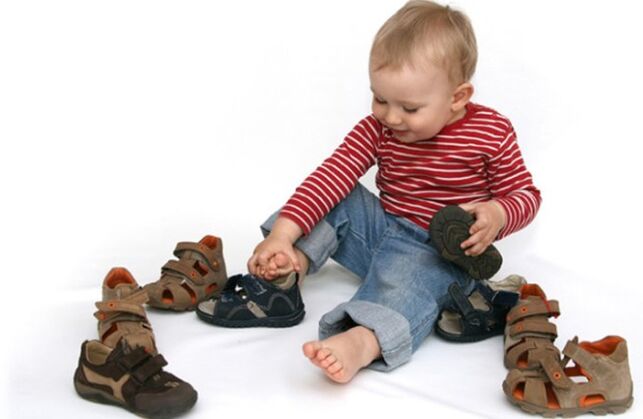
When choosing such shoes, you should pay attention to the following points:
- Shoes should be made from natural breathing materials;
- The child should feel comfortable in it, should not lubricate or rub it anywhere;
- It is necessary to have a solid, tall ass, so that the ankle joint and the heel are recorded in the correct position;
- The presence of fasteners that regulate the shoes in the width of the foot;
- The presence of a small, wide heel, ideally, the "heel of Thomas" (on the inside of the foot is a little longer than from the outer one).
Medical Physical Education and Exercises for Daily Perform at Home
Exercises should be performed daily, here are some of them:
- alternating socks and walking on the heels (first with raised, then caught fingers) for 5 minutes;
- Sitting on the floor with his legs outstretched to squeeze and cancel her toes;
- You can suggest the child try to lift different small items from the floor;
- Walking on an uneven surface, for example, can be brought home with river pebbles or buy a massage carpet;
- walking along the outer edge of the foot;
- Knowing a wooden roller or a small ball;
- Rotation from legs from left to right and back.
Massage and physiotherapy
The massage is performed at home, courses for 2-3 weeks, then rest.This will help to strengthen the muscles and relieve them of stress, so it does not require special skills.The total massage time is 20-30 minutes.You need to start with a common massage - the child in a lying stomach, the hands are lengthened on the body, the head is facing the side.Hand movements should not cause baby pain:
- It is easy to caress the palms on the back, gradually increasing the pressure;
- Pat the witches with the edge of the palm, light a pinch;
- Arrange the folds of the skin in the direction of the lower back to the shoulders;
- Complete the rear massage by taining;
- Repayment of the legs from heels to the butt and back, it is easy to pinch;
- Mark the legs and thigh muscles;
- Finish your feet.
- Rub your legs with the edge of the palm, gradually increasing the pressure;
- The thumb of the hand "draws" the number 7 on the sole;
- With one hand, keep your legs to the heel, the second - rub the ankle joint;
- It's easy to pull your feet to your fingers "on yourself."
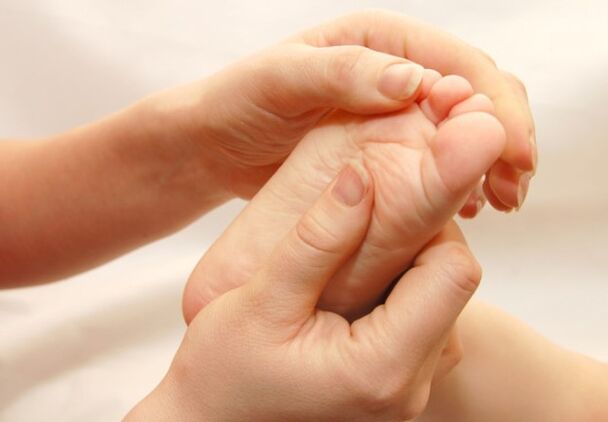
If necessary, the doctor may prescribe physiotherapy, for example: magnetotherapy, acupuncture, electrophoresis, paraffin packaging.This will improve metabolism in the problem area and help to achieve complete absorption of drugs.
Surgery
In exceptional cases where complex therapy does not work, parents are invited to solve the problem surgically.Modern methods used in the operation allow you to do without metal structures and carrying plaster.The doctor adjusts the direction of the connections and evens out the angle of the location of the legs.After correction, the recovery period and the mandatory wearing of orthopedic shoes should be followed.
Is it possible to completely cure deformation?
With a timely call to a specialist and a serious approach to treatment, it is quite possible to straighten squamous.At the same time, treatment should be started by the age of two, and then you can completely get rid of the curvature of the legs.In children over 2 years and with advanced deformity of the lower limbs, it is quite difficult to cure the disease to the end, but you can greatly improve the situation.
What can be the consequences if you do not treat the curvature?
Plates in children will not be corrected themselves, so the symptoms of pathology cannot be ignored.Such a deviation of the legs leads to a change in the entire musculoskeletal system.Due to the unevenly distributed load, there are problems with the knee and coxophemoral joints, as well as the spine.Not only does the gait break, but it also becomes impossible physical activity (running, active games), because it causes pain and inflammation in the joints.
- Starting from the newborn period, it is necessary to monitor the development of the baby's feet, to inspect them for injuries, to do easy massage and gymnastics.They should be subjected to preventive examinations in the orthopedist and in his absence to the surgeon.
- You should not put the baby too early on your feet - for the fragile muscles of the legs and joints, this is a huge load.When he feels the power, he will try to get up, sticking to support.For the same reason, the use of walkers and jumpers is undesirable, at least up to eight months.
- Particular attention should be paid to the gait - it must be correct and appropriate to age.With the least doubt, you should consult a specialist.
- Children's shoes should be of high quality, with a small heel and orthopedic insole (we recommend reading: insoles for children with flat legs).From seven months, when the child starts to stand on his feet, it is recommended to wear light sandals with a hard back so that the leg will be fixed in the correct position, the load of the muscles and joints will be distributed evenly.If there is a deformation of a stop 1-2 degrees, it is advisable to buy orthopedic shoes at specialist stores and pharmacies.
- Prevention of rickets.The child should spend enough time on the street as vitamin D is formed in the skin under the influence of sunlight.For the prevention, you can give your child a vitamin D at a dose prescribed by a doctor.It is necessary to provide a complete, balanced diet.
- In the summer, it is useful to give the child to work barefoot, small pebbles have a massage effect.At home, use a massage carpet with various irregularities every day for a few minutes.
- Exercise strengthens the musculoskeletal system and prevents the development of flat feet.If possible, you can enroll a child for swimming or in the sports section (we recommend reading: How to swim for newborns in the bathroom or pool?).
